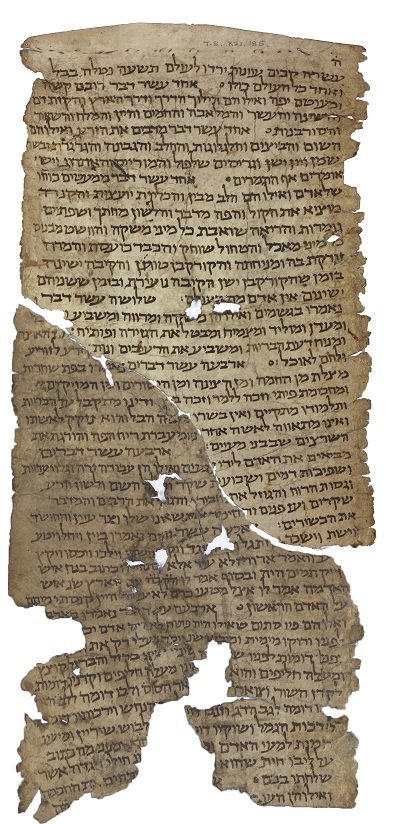The rotuli corpus of the medieval midrash Pirqa de-Rabbenu ha-Qadosh
by Anna Busa - École Pratique des Hautes Études (France) / Goethe University Frankfurt (Germany)
The Cairo Genizah proves to be an important source for historical insights into the material, socio-economic and intellectual contexts of Oriental Jewry. The fragments and texts in the Genizah contain early and rare text compositions and collections that provide valuable information on the production and circulation of physical artefacts as well as the creation, transmission and use of literary compilations in the Middle Ages.
During my PhD research, which focusses on the mapping of the textual transmission, and the electronic editing, of multiple variants of the medieval midrash Pirqa de-Rabbenu ha-Qadosh, I encountered more than one hundred manuscripts of this unstudied numerical midrash in the Cairo Genizah. Its earliest fragments stem from the 11th century and enumerate anonymous short, gnomic sayings and halakhic dicta in an anthological manner, which are grouped according to numbers from three onward. These sayings are found in a multitude of textual variants in the physical forms of megillot (scrolls), codices (books) and rotuli (vertical bookrolls inscribed on the short side).
The rotuli corpus of this midrash was initially pieced together by Judith Olszowy-Schlanger in 2012, and she then researched the Genizah with Gideon Bohak looking for evidence that this specific and, so far little studied, format constituted a widely used, cheap, and popular third form of the Hebrew book. Sifting through my midrashic material, fragment L-G Talm. II.95 proved to be a complementary piece to this corpus revealing several interesting aspects.
The fragment L-G Talm. II.95 constitutes an adjacent piece to T-S K21.85 that has been torn obliquely, showing stitching marks on its top margin. Both fragments complete rotulus T-S K21.94 which shows stitching marks on its bottom and whose textual content precedes and seamlessly joins to these, hinting at the rotulus distinct physical format. Hence, the fragments form a long narrow strip of parchment, whose recto and verso are densely inscribed in one column showing Oriental square script. With a width of 10cm, the so far identified pieces of this yet incomplete rotulus (T-S H7.21, MS Bodl. Heb a. 2 fol. 24, T-S K21.94, T-S K21.85 & L-G Talm. II.95) amount to a length of more than 170cm.
Bodleian Libraries and Cambridge University Library L-G Talm. II.95 (bottom) and T-S K21.85 (top)
While rotuli are an excellent example of cheap and user-friendly books which are portable, easily producible and acquirable so that they suit everyday purposes, the midrashic text qua text offers a literary structure that besides the material form merits further investigation.
The halakhic dicta appearing on the fragments are grouped according to numbers with no apparent thematic relation so that an ‘open’ text is created which invites deliberate rearrangement, reworking, and rewording by people who created and used it. Indeed, the manifold variants of this midrash in the Genizah point to its popularity and to its personalized use that involves a highly active handling of the textual excerpts. This last feature poses severe difficulties to the determination of the textual transmission and its history, leaving the question of what editorial techniques should be applied in order adequately to capture the midrash’s distinct textual characteristics.
These points taken together, the materiality, textual structure and content of this midrash reveal important insights into the book culture and daily life of Jewish people in the Middle Ages, as it seems that these cheap, small-sized, thus portable, and user-friendly bookrolls comprising popular literature served people for their everyday purposes of work, personal study and recreation.
Bibliography
- Bohak, Gideon, “The Magical Rotuli from the Cairo Genizah”, edited by Gideon Bohak, Yuval Hariri, and Shaul Shaked. Continuity and Innovation in the Magical Tradition, Leiden: Brill 2011, pp. 321–340.
- Klinck, Anne L., “Editing Cursor Mundi: Stemmata and the ‘Openʼ Text”, edited by Eckard, Sian, Partridge, Stephen. The Book Unbound. Editing and Reading Medieval Manuscripts and Texts, Toronto 2004, pp. 3–15.
- Olszowy-Schlanger, Judith, “The Third Form of the Hebrew Book: Rotuli from the Cairo Genizah”, Report of the Oxford Centre for Hebrew and Jewish Studies, 2010–2011, pp. 89–93.
- —, “Un rotulus du midrash Pirqa de-Rabbenu ha-Qadosh de la Geniza du Caire”, Annuaire de l’École Pratique des Hautes Études (EPHE), Section des sciences historiques et philologiques 145 (2014), pp. 26–40.
- —, “Cheap Books in Medieval Egypt: Rotuli from the Cairo Geniza”, Intellectual History of the Islamicate World 4 (2016), pp. 82–101.
- Ta-Shma, Israel, “The ‘Open’ Book in Medieval Hebrew Literature: The Problem of Authorized Editions”, Bulletin of the John Rylands University Library of Manchester 75 (1993), pp. 17–24.
Cite this article
(2017). The rotuli corpus of the medieval midrash Pirqa de-Rabbenu ha-Qadosh. [Genizah Research Unit, Fragment of the Month, July 2017]. https://doi.org/10.17863/CAM.28078
If you enjoyed this Fragment of the Month, you can find others here.
Contact us: genizah@lib.cam.ac.uk
The zoomable images are produced using Cloud Zoom, a jQueryimage zoom plugin:
Cloud Zoom, Copyright (c) 2010, R Cecco, www.professorcloud.com
Licensed under the MIT License

